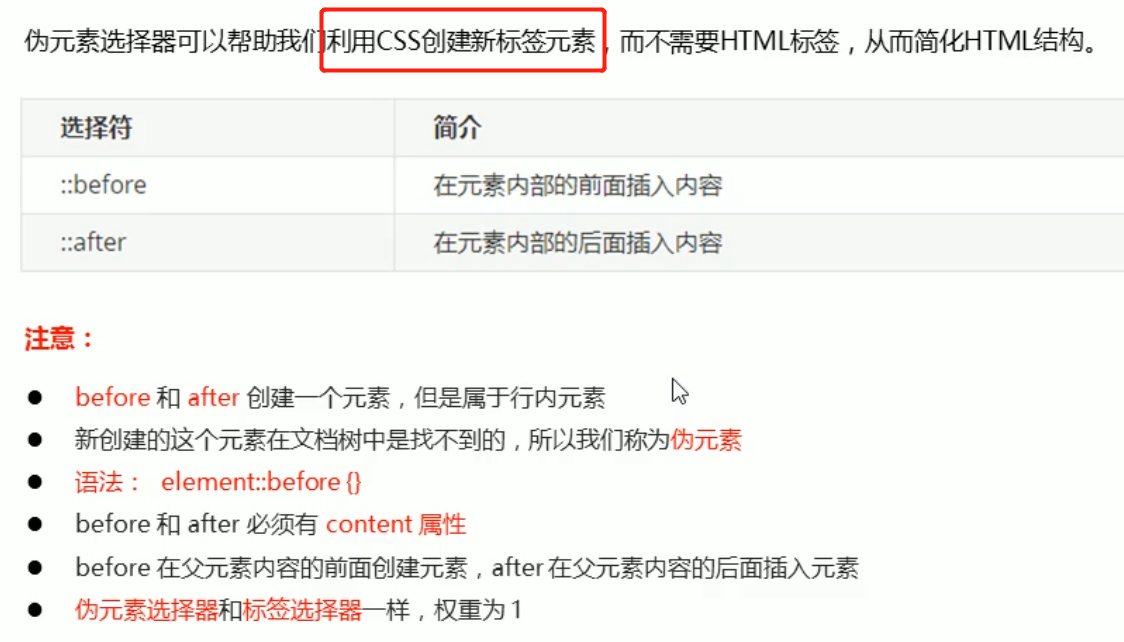3.伪元素选择器(重要)
其实这个伪元素选择器我们之前在清除浮动的时候就已经见过了,通过CSS在父盒子的前后各生成一个清除浮动的伪元素,从而限制浮动盒子的范围。也就是::before和::after块
所有 CSS 伪元素
| 选择器 | 例子 | 例子描述 |
|---|---|---|
| ::after | p::after | 在每个 元素之后插入内容。 |
| ::before | p::before | 在每个 元素之前插入内容。 |
| ::first-letter | p::first-letter | 选择每个 元素的首字母。 |
| ::first-line | p::first-line | 选择每个 元素的首行。 |
| ::selection | p::selection | 选择用户选择的元素部分。 |
请注意,CSS3中的伪元素和之前学习的伪类不一样,是新的特性,以下是CSS的伪类:
所有 CSS 伪类
| 选择器 | 例子 | 例子描述 |
|---|---|---|
| :active | a:active | 选择活动的链接。 |
| :checked | input:checked | 选择每个被选中的 元素。 |
| :disabled | input:disabled | 选择每个被禁用的 元素。 |
| :empty | p:empty | 选择没有子元素的每个 元素。 |
| :enabled | input:enabled | 选择每个已启用的 元素。 |
| :first-child | p:first-child | 选择作为其父的首个子元素的每个 元素。 |
| :first-of-type | p:first-of-type | 选择作为其父的首个 元素的每个 元素。 |
| :focus | input:focus | 选择获得焦点的 元素。 |
| :hover | a:hover | 选择鼠标悬停其上的链接。 |
| :in-range | input:in-range | 选择具有指定范围内的值的 元素。 |
| :invalid | input:invalid | 选择所有具有无效值的 元素。 |
| :lang(language) | p:lang(it) | 选择每个 lang 属性值以 “it” 开头的 元素。 |
| :last-child | p:last-child | 选择作为其父的最后一个子元素的每个 元素。 |
| :last-of-type | p:last-of-type | 选择作为其父的最后一个 元素的每个 元素。 |
| :link | a:link | 选择所有未被访问的链接。 |
| :not(selector) | :not(p) | 选择每个非 元素的元素。 |
| :nth-child(n) | p:nth-child(2) | 选择作为其父的第二个子元素的每个 元素。 |
| :nth-last-child(n) | p:nth-last-child(2) | 选择作为父的第二个子元素的每个 元素,从最后一个子元素计数。 |
| :nth-last-of-type(n) | p:nth-last-of-type(2) | 选择作为父的第二个 元素的每个 元素,从最后一个子元素计数 |
| :nth-of-type(n) | p:nth-of-type(2) | 选择作为其父的第二个 元素的每个 元素。 |
| :only-of-type | p:only-of-type | 选择作为其父的唯一 元素的每个 元素。 |
| :only-child | p:only-child | 选择作为其父的唯一子元素的 元素。 |
| :optional | input:optional | 选择不带 “required” 属性的 元素。 |
| :out-of-range | input:out-of-range | 选择值在指定范围之外的 元素。 |
| :read-only | input:read-only | 选择指定了 “readonly” 属性的 元素。 |
| :read-write | input:read-write | 选择不带 “readonly” 属性的 元素。 |
| :required | input:required | 选择指定了 “required” 属性的 元素。 |
| :root | root | 选择元素的根元素。 |
| :target | #news:target | 选择当前活动的 #news 元素(单击包含该锚名称的 URL)。 |
| :valid | input:valid | 选择所有具有有效值的 元素。 |
| :visited | a:visited | 选择所有已访问的链接。 |

